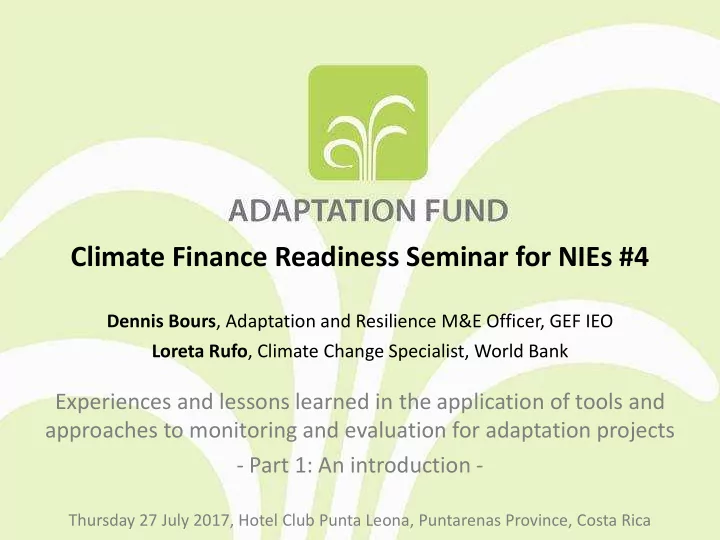

Climate Finance Readiness Seminar for NIEs #4 Dennis Bours , Adaptation and Resilience M&E Officer, GEF IEO Loreta Rufo , Climate Change Specialist, World Bank Experiences and lessons learned in the application of tools and approaches to monitoring and evaluation for adaptation projects - Part 1: An introduction - Thursday 27 July 2017, Hotel Club Punta Leona, Puntarenas Province, Costa Rica
Outline of Presentation • M&E - What - Where - and Why?
M&E – What? Monitoring Monitoring Evaluation Evaluation Part of good day-to-day management Activity in a longer-term process “Are we doing the things right?” “Are we doing the right things?” -> To improve -> To prove Timing Timing Continuously throughout the Periodic review at fixed points in project’s implementation time, eg. baseline, mid-term, closing. Scope Scope Day to day activities, outputs, Assess overall delivery of outputs, indicators of progress and change progress towards objectives and goal Main Main Project staff, project users External evaluators, project users, participants participants project staff, donors Process Process Regular meetings, interviews, Special meetings, additional data monthly / quarterly reviews, etc. collection exercises, etc. Written Written Regular reports, updates to project Written report and recommendations outputs outputs users, management and donors for changes to project or for future projects, presented to stakeholders Also have a look at: Adaptation Fund, 2010. Project Level Results Framework and Baseline Guidance Document. AFB/EFC.3/3. Adaptation Fund, 2012. Evaluation Framework. Adaptation Fund, 2012. Guidelines for Adaptation Fund Project/Programme Final Evaluations.
M&E – Where and why? INVESTMENT INPUTS ACTIVITIES OUTPUTS OUTCOMES IMPACT Adaptation Resources, Methodology, Direct, Likely or Long-term wide Fund grant staff Tasks and work Immediate achieved spread changes results, products Short- and or effects or services medium term produced effects of PLANNED WORK outputs INTENDED RESULTS Can be controlled Under direct Under indirect influence influence Based on CSIRO’s pathways to impact, in: Morgan, B., 2014. Research impact: Income for outcome, Nature 511, S72 – S75. Also look at: Adaptation Fund, 2010. Project Level Results Framework and Baseline Guidance Document. AFB/EFC.3/3.
M&E – Where and why? INVESTMENT INPUTS ACTIVITIES OUTPUTS OUTCOMES IMPACT Adaptation Resources, Methodology, Direct, Likely or Long-term wide Fund grant staff Tasks and work Immediate achieved spread changes results, products Short- and or effects or services medium term produced effects of Efficiency outputs Effectiveness Cost efficiency Cost effectiveness Results / Project’s performance
M&E – Where and why? Efficiency relates to how well inputs are converted into a specific output OECD/DAC: “A measure of how economically resources / inputs (funds, expertise, time, etc.) are converted to results.” Cost-efficiency compares the cost against outputs and can be expressed as a unit cost by unit output. Effectiveness relates to how well outputs are converted into outcomes OECD/DAC: “The extent to which the intervention’s objectives were achieved” Cost effectiveness is the cost of achieving intended outcomes or impacts. Eg. to compare the costs of alternative ways of producing the same or a similar outcome.
M&E – Some monitoring questions INVESTMENT INPUTS ACTIVITIES OUTPUTS OUTCOMES IMPACT Monitoring - Efficiency Are finance, personnel and materials available on time and in the right quantities and quality? Monitoring – Cost effectiveness Are activities being implemented on schedule and within budget? Are activities leading to the expected outputs? Monitoring - Effectiveness Are outputs leading to achievement of the outcomes? How do key stakeholders feel about the Monitoring – Adaptive management results? What is causing delays or unexpected results? Is there anything happening that should lead management to modify the project’s implementation plan? IFRC, 2011. Project/programme planning - Guidance manual, 11.
M&E – Some evaluation questions INVESTMENT INPUTS ACTIVITIES OUTPUTS OUTCOMES IMPACT Evaluation - Efficiency Were activities implemented on schedule and within budget? Were outputs delivered economically? Evaluation - Effectiveness Were the operation’s objectives achieved? Did the outputs lead to the intended outcomes? Evaluation - Relevance Were objectives consistent with needs? Evaluation – Impact What changes did the project bring about? Were there any unplanned or unintended changes? Evaluation – Sustainability Are the benefits likely to be maintained for an extended period after the project has closed? IFRC, 2011. Project/programme planning - Guidance manual, 14.
Resources used, in order of appearance • Adaptation Fund, 2010. Project Level Results Framework and Baseline Guidance Document. AFB/EFC.3/3. • Adaptation Fund, 2012. Evaluation Framework. • Adaptation Fund, 2012. Guidelines for Adaptation Fund Project/Programme Final Evaluations. • IFRC, 2011. Project/programme planning - Guidance manual. • OECD/DAC, 2010. Glossary of Key Terms in Evaluation and Results Based Management. • Climate-Eval, 2015. Good Practice Study on Principles for Indicator Development, Selection, and Use in Climate Change Adaptation Monitoring and Evaluation. • Biagini, B., et. al, 2014. A typology of adaptation actions: A global look at climate adaptation actions financed through the Global Environment Facility, Global Environmental Change journal, 25, 97 – 108.
Some more resources • Monitoring & evaluation for climate change adaptation and resilience: A synthesis of tools, frameworks and approaches • AdaptME Toolkit • Guidance note 1: Twelve reasons why climate change adaptation M&E is challenging • Guidance note 2: Selecting indicators for climate change adaptation programming • Guidance note 3: Theory of Change approach to climate change adaptation programming • Evaluation Review 1: Design, monitoring, and evaluation in a changing climate: Lessons learned from agriculture and food security programme evaluations in Asia • Evaluation Review 2: International and donor agency portfolio evaluations: Trends in monitoring and evaluation of climate change adaptation programmes • Evaluation Review 3: valuating programmes through a climate adaptation lens: Reflections from coastal areas in Asia and the Pacific • GIZ Adaptation made to measure - A guidebook to the design and results-based monitoring of climate change adaptation projects • GIZ Good Practices on Planning, Implementing and Monitoring & Evaluating Ecosystem-based Adaptation to climate change • http://www.adaptationcommunity.net/ • http://www.climate-eval.org/ • http://climate.dennisbours.com/
Thank you! Dennis Bours adaptationfund Adaptation and Resilience M&E Officer, GEF IEO @adaptationfund Dbours@thegef.org
Recommend
More recommend